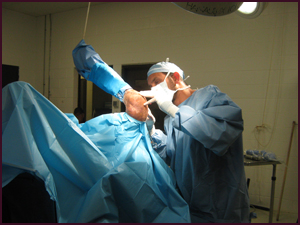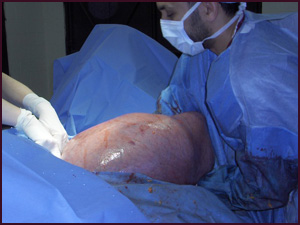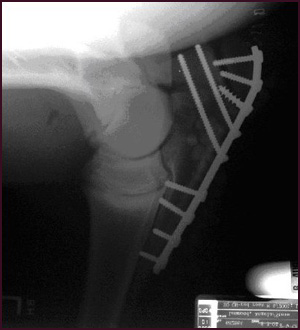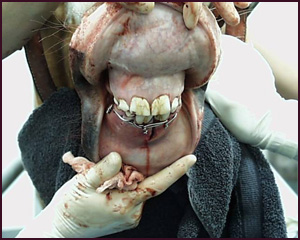A wide range of orthopedic, soft tissue, and abdominal procedures are performed in a modern operating room by our board-certified surgeons. Our facility utilizes the newest, most advanced anesthetic equipment to support and monitor anesthetized patients. A few of the procedures are listed below. Please click on the procedure to learn more.

Arthroscopy means scoping or looking into a joint by means of a miniature telescope called an Arthroscope. The Arthroscope is connected to a camera source and a view of the joint is projected onto a full screen television. Some advantages of arthroscopy include: minimally invasive, better view of the joint and all its components, decreased after effects of surgery, improved cosmetic appearance, and quicker return to use in most cases.
Procedures done using an arthroscope include:
The horses are usually in dorsal recumbancy (on their back) on a well padded surgical table. Once the horse is in surgery they are placed on a ventilator which delivers inhalant anesthetics and 100% oxygen. All horses under anesthesia have an anesthetist and are very closely monitored using the newest and most advanced anesthetic equipment such as direct blood pressure monitoring, ECG, and blood gas analysis. The patient is kept on a continuous infusion of fluids, electrolytes, and if needed blood pressure medicine.
During surgery the doctor will make a couple stab incisions, insert the arthroscope, evaluate the joint, and remove any chips. A typical arthroscopy lasts anywhere from 45 minutes to 2 hours. The doctor will close the incisions with sutures and bandage the leg.
In recovery, the horse is put in lateral recumbancy (on its side), in a quiet, dark, well padded recovery stall. The patient is kept on oxygen and the anesthetist closely monitors the horse until it is standing which usually takes 30 minutes to one hour post op.
All owners are welcome to view the surgery through a viewing window.
Colic in horses is defined as abdominal pain, but it is a clinical sign rather than a diagnosis. The term colic can encompass all forms of gastrointestinal conditions which cause pain as well as other causes of pain not involving the gastrointestinal tract. The most common forms of colic are gastrointestinal in nature and are most often related to colonic disturbance. There are a variety of different causes of colic, some of which can prove fatal without surgical intervention. Colic surgery is major abdominal surgery, often with intensive aftercare. When making the decision for surgery, the following must be considered and interpreted:
It is important to understand that the previous parameters do not usually give us an exact diagnosis and therefore the surgery begins as an exploratory.
Horses needing emergency surgical intervention are stabilized and immediately taken to surgery. The patient is placed in dorsal recumbancy (on their back) on a well padded surgical table. Once the horse is in surgery it is placed on a ventilator which delivers inhalant anesthetics, and 100% oxygen. Horses experiencing a surgical colic are usually bloated and have a hard time ventilating themselves adequately. The ventilator/vaporizer maintains the horse at a surgical plane of anesthesia and insures the horse is being adequately ventilated. All horses under anesthesia have an anesthetist and are very closely monitored using the newest and most advanced anesthetic equipment such as direct blood pressure monitoring, ECG, and blood gas analysis. The patient is kept on a continuous infusion of fluids, electrolytes, and if needed blood pressure medicine.
A developmental defect marked by the failure of one or both of the testes to descend into the scrotum. The retained testis does not produce fertile sperm but does produce testosterone which gives the stallion its behavioral characteristics; cryptorchid testes are more prone to developing tumors compared to descended testes and the cost of castration is increased.
In surgery, the horse is in dorsal recumbancy (on their back) on a well padded surgical table. Once the horse is in surgery they are placed on a ventilator which delivers inhalant anesthetics and 100% oxygen. All horses under anesthesia have an anesthetist and are very closely monitored using the newest and most advanced anesthetic equipment such as direct blood pressure monitoring, ECG, and blood gas analysis. The patient is kept on a continuous infusion of fluids, electrolytes, and if needed blood pressure medicine.
The horse undergoes a sterile prep the surgeon then drapes the horse and makes a small incision into the scrotum or inguinal area. The surgery lasts anywhere from 30 minutes to 1.5 hours.
Once both testicles are removed the horse is moved to the recovery stall. The horse is put in lateral recumbancy (on its side), in a quiet, dark, well padded recovery stall. The patient is kept on oxygen and the anesthetist closely monitors the horse until it is standing which usually takes 30 minutes to one hour post op. The hospital stay is usually one to three days.
We have ACVS boarded veterinary surgeons on staff to perform surgery on your cryptorchid. To learn more about Cryptorchidism click the following link:
http://www.acvs.org/AnimalOwners/HealthConditions/LargeAnimalEquineTopics/UndescendedTesticlesinHorses/
There are many different types of angular limb deformities in foals. Some of these deformities need immediate attention and others do not. If you have a foal that you believe has a deformity contact your veterinarian immediately and they can council you on your particular problem. Some need surgical intervention if this is the case we will schedule an appointment to evaluate the foal and council you on the procedure that needs to be performed.
We have ACVS board certified surgeons on staff to help you with your angular limb deformities. Please click the following link to learn more about Angular Limb Deviations http://www.acvs.org/AnimalOwners/HealthConditions/LargeAnimalEquineTopics/AngularLimbDeviationinHorses/

Cesarean section (C-section) is indicated in various types of dystocia. We have veterinarians and a board certified surgeon available 24 hours a day seven days a week for emergency surgeries such as this. The mare is first evaluated standing if a normal delivery is not possible we will anesthetize the mare and try to deliver the foal vaginally. If vaginal delivery jeopardizes the health of the mare or the foal or if it is likely to impair the mares subsequent fertility we will immediately move the mare to surgery to perform a c-section.
The mare is placed in dorsal recumbancy (on her back) on a well padded surgical table. Once she is in surgery she is placed on a ventilator which delivers inhalant anesthetics, and 100% oxygen. The foal takes up a lot of space in the abdomen making it hard for the mare to ventilate herself adequately. The ventilator/vaporizer maintains the horse at a surgical plane of anesthesia and insures the horse is being adequately ventilated. All horses under anesthesia have an anesthetist and are very closely monitored using the newest and most advanced anesthetic equipment such as direct blood pressure monitoring, ECG, and blood gas analysis. The patient is kept on a continuous infusion of fluids, electrolytes, and if needed blood pressure medicine.
The mare is clipped and undergoes a sterile prep on the ventral abdomen. The surgeon then drapes the entire horse and an incision approximately 12-20 inches long is made on the midline of the abdomen. The uterus is exteriorized and an incision is made into the uterus giving access to the foal. The foal team pulls the foal from the uterus, an endotracheal tube is placed immediately, the foal is placed on oxygen, and an IV drip is started. The mare team will begin to suture the uterus, and close the abdomen. The surgery lasts approximately 2 hours.
In recovery, the mare is put in lateral recumbancy (on her side), in a quiet, dark, well padded recovery stall. The patient is kept on oxygen and the anesthetist closely monitors the horse until it is standing which usually takes 30 minutes to one hour post op.
All owners are welcome to view the surgery through a viewing window.
A few of the different airway and sinus surgeries we perform at the hospital are: Tie Back, Maxillary Sinus Flap, Hyovertibrotomy, Modified Forsell’s (cribbing), Strap Muscle Resection, Arytenoidectomy, Epiglottic Entrapment Reduction, Tracheostomy, and Tie Forward.
Very few of the airway surgeries can be done standing with a local block. Most airway surgeries are done under general anesthesia the horse is clipped and undergoes a sterile prep on the surgical site. The surgeon then drapes surgical site and an incision is made. Once the procedure is finished the incision is closed and the horse is moved to recovery.
In recovery, the horse is put in lateral recumbancy (on its side), in a quiet, dark, well padded recovery stall. The patient is kept on oxygen and the anesthetist closely monitors the horse until it is standing which usually takes 30 minutes to one hour post op.
We have board certified surgeons on staff to repair many types of fractures including: limb fractures, sinus fractures, and jaw fractures. Please click on the following link to learn more about stabilizing, transporting, managing, and decision making when dealing with limb fractures.
http://www.acvs.org/AnimalOwners/HealthConditions/LargeAnimalEquineTopics/EquineFractures/


A “disorder” in which a part of the body protrudes abnormally through a tear or opening in an adjacent part. In the abdomen, this applies to intestine which can herniate through the inguinal rings, through an open umbilicus or through a hole in the diaphragm. Because the hole in the cavity wall is usually small, this commonly results in strangulation of the herniated intestine. As with other causes of intestinal strangulation, the affected gut has to be removed if the horse is to survive.
Unfortunately, hernias into the diaphragm and inguinal rings are usually emergency procedures. On the other hand, abdominal hernia’s can be fixed pro-actively before there is any compromise to the intestine. If you think your foal may have a hernia do not hesitate to have a veterinarian check the foal.
If your horse has an abdominal hernia which needs to be repaired surgically we will schedule a time that is convenient for you. Your horse will need to be dropped off the night before surgery. The day of surgery the patient is given a sedative and an induction agent. He/she is placed in dorsal recumbancy (on their back) on a well padded surgical table. Once the horse is in surgery it is placed on a ventilator which delivers inhalant anesthetics, and 100% oxygen. The ventilator/vaporizer maintains the horse at a surgical plane of anesthesia and insures the horse is being adequately ventilated. All horses under anesthesia have an anesthetist and are very closely monitored using the newest and most advanced anesthetic equipment such as direct blood pressure monitoring, ECG, and blood gas analysis. The patient is kept on a continuous infusion of fluids, electrolytes, and if needed blood pressure medicine.
The horse is clipped and undergoes a sterile prep on the ventral abdomen. The surgeon then drapes the entire horse and an incision directly over the hernia is made. The intestine is then reduced into the abdomen and the abdominal wall is closed in a two layer fashion. The surgery usually lasts around 30 minutes. Herniations that require emergency surgical intervention usually require the compromised intestine be removed and therefore the surgery is significantly longer, lasting 2-4 hours.
In recovery, the horse is put in lateral recumbancy (on its side), in a quiet, dark, well padded recovery stall. The patient is kept on oxygen and the anesthetist closely monitors the horse until it is standing which usually takes 30 minutes to one hour post op.
Procedures that are commonly done using a laparoscope are:
Depending on the procedure the horse will either be anesthetized or a standing local anesthesia is administered as well as sedation.